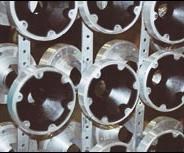Electropolishing as a Pretreatment for Anodizing
Electropolishing can be a pretreatment for anodizing or a substitute for bright dipping. Either way, it improves the surface of the aluminum...
Electropolishing is the electrolytic removal of metal in a highly ionic solution by means of an electrical potential and current or, in other words, reverse electroplating. So what are the benefits of using electropolishing as part of an anodizing process? Plenty, as Fort Wayne Anodizing has found out. Not only does electropolishing provide a decorative surface and act as a replacement for bright dip, it improves the aluminum surface prior to anodizing by smoothing out the peaks and valleys.
Electropolishing removes metal from the surface while producing a unidirectional pattern that is stress and occlusion free, microscopically smooth and highly reflective. Deburring is accomplished quickly because of the higher current densities used, enabling the constant exposure of the burr tip. The combination of no directional lines from mechanical finishing, plus a surface relatively free of hydrogen, results in a hygienically clean surface.
Electropolishing aluminum does not produce toxic fumes, require fume hoods, produce corrosion or require high temperatures. To control the bath, FWA takes the specific gravity and checks the aluminum metal content.
"We see it as a big advantage over bright dipping," stated Dennis Fulford, sales manager. "Bright dipping aluminum produces nitrogen dioxide, which is toxic. Also, you have to run the bath at a higher temperature (194-205F), which requires more heat and hence more money. Another issue is that the bright dip bath has several variables that need to be controlled in order to produce good work."
Neither is an aluminum electropolishing bath the same as a stainless steel electropolishing bath. Chemistries as well as parameters differ. See Table I.
However, much like their steel counterparts, aluminum pieces are cleaned prior to electropolishing. Aluminum parts first go through degreasing, unless they are heavily soiled, in which case they are etched. FWA tries to avoid this as much as possible because the etching can mar the surface of the aluminum. After degreasing and rinsing, parts are desmutted and run through more rinses before entering the electropolishing tank. After electropolishing, parts are rinsed and run back through the desmut tank to clean off any oils they may have picked up in the rinse tanks. Now they are ready for either conventional or hardcoat anodizing.
FWA offers both conventional anodizing, as well as hard coat anodizing, chromate conversion coating, vacuum impregnation and the Metabrite Process. The customers who have requested the electropolishing have been mostly from the medical field, appliance and heavy truck industries. Many want the bright electropolish with an anodized and clear finish for items such as headlamp bezels, side mirror brackets and grilles. The medical industry requests the process because of how well it removes burrs, which is extremely important when dealing with surgical equipment. These items are also dyed. FWA has eight standard colors it offers from black and clear to purple and yellow. Some of the medical equipment is color-coded.
Fort Wayne Anodizing's slogan is "It's not how it's made. It's how it's made to last." And now it offers its customers one more way to make their products last longer and look better. "Traditionally, our customers relied on FWA to provide them with a matte or stain finish. With the electropolish, we can give them more options for a brighter anodize," stated Mr. Fulford.
Related Content
Trivalent Chrome Overview
As the finishing industry begins to move away from the use of hexavalent chromium to trivalent chromium, what factors should finishers consider as they make new investments? Mark Schario, chief technology officer for Columbia Chemical offers a helpful overview of this complicated topic.
Read MoreProducts Finishing Reveals 2024 Qualifying Top Shops
PF reveals the qualifying shops in its annual Top Shops Benchmarking Survey — a program designed to offer shops insights into their overall performance in the industry.
Read More10 Anodizing Best Practices
Following this list of guidelines can help to increase the performance, cost effectiveness and quality for your anodizing operation.
Read MoreNADCAP Shop Digitizes to Eliminate Paper Trail
Customizable ERP software has transformed a 27-year-old manual metal finishing job shop into a state-of-the-art paperless company with full digital traceability in about 10 months.
Read MoreRead Next
Episode 45: An Interview with Chandler Mancuso, MacDermid Envio Solutions
Chandler Mancuso, technical director with MacDermid Envio discusses updating your wastewater treatment system and implementing materials recycling solutions to increase efficiencies, control costs and reduce environmental impact.
Read MoreEducation Bringing Cleaning to Machining
Debuting new speakers and cleaning technology content during this half-day workshop co-located with IMTS 2024.
Read MoreA ‘Clean’ Agenda Offers Unique Presentations in Chicago
The 2024 Parts Cleaning Conference, co-located with the International Manufacturing Technology Show, includes presentations by several speakers who are new to the conference and topics that have not been covered in past editions of this event.
Read More























